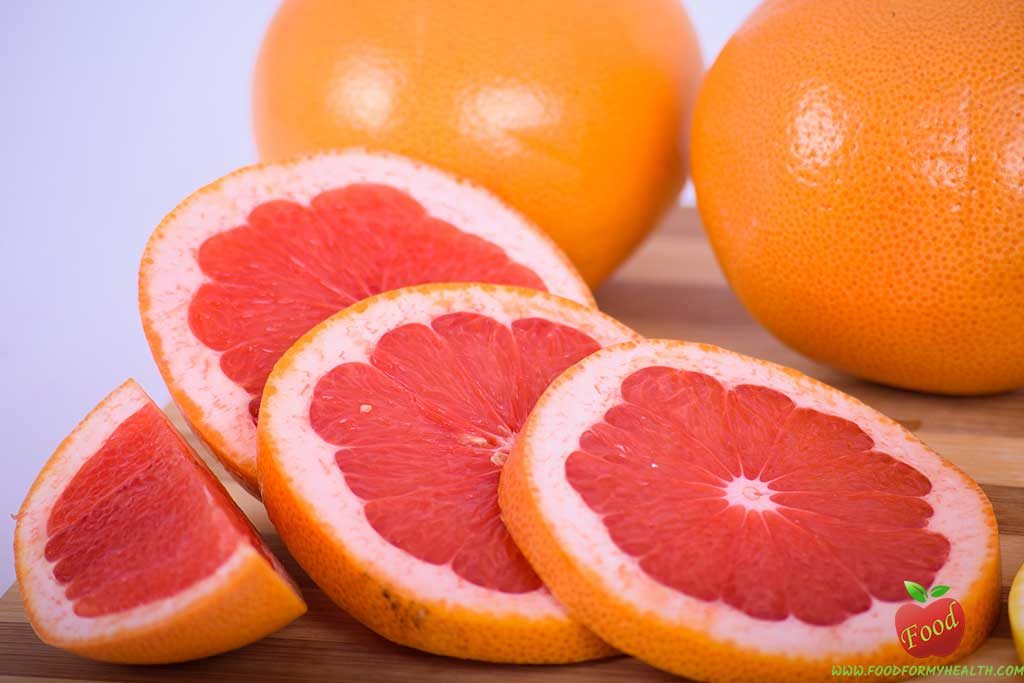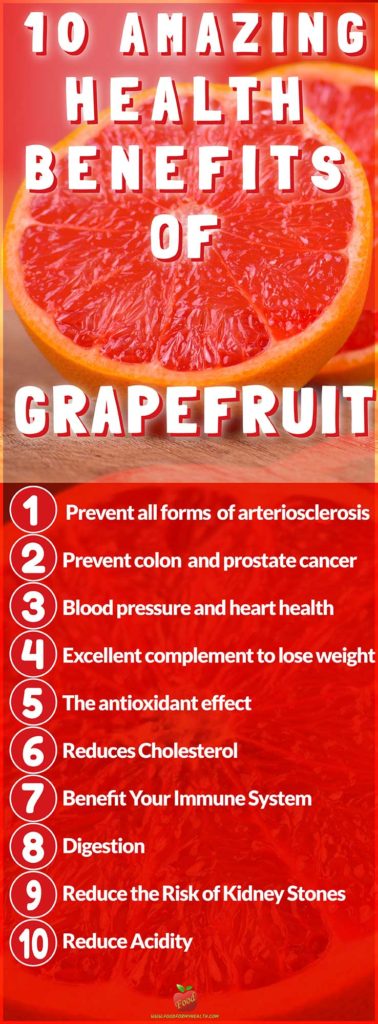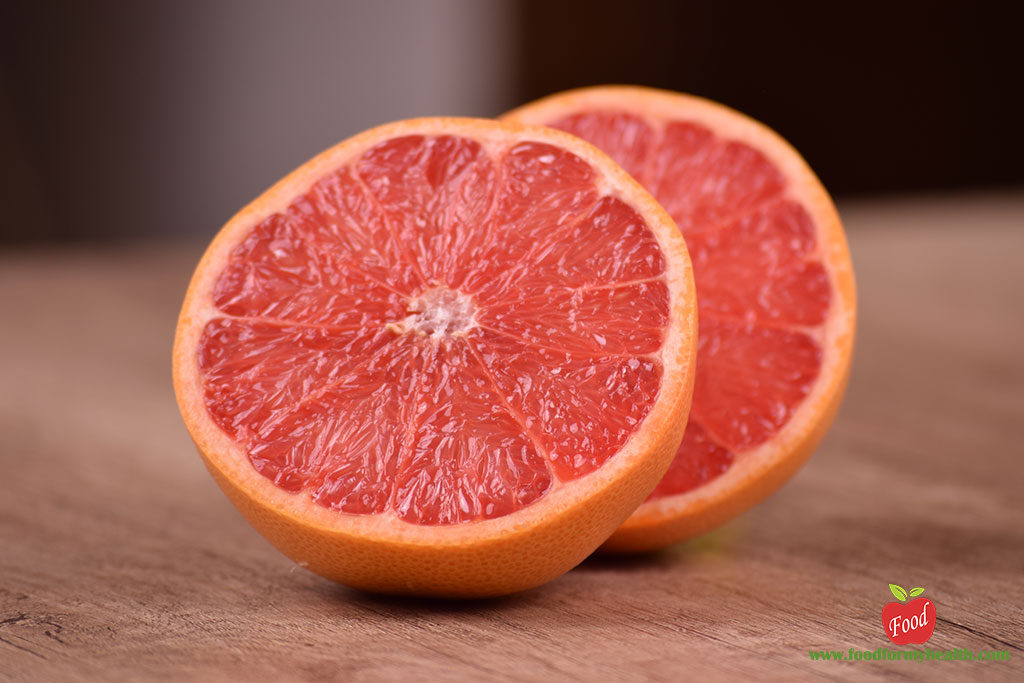10 Amazing Health Benefits of Grapefruit
Some of the major health benefits of Grapefruit are that unblocks the arteries and cleanses the blood, and has preventive action against cancer.
There are varieties of grapefruit with yellow, orange, and even pink pulp and is the fruit of the tree ‘Citrus paradisi’ from the botanical family Rutaceae. Originally from Southeast Asia, its cultivation has spread to Israel, Mediterranean countries, North and South America, Australia, and South Africa.
If you never tasted a grapefruit before, the first experience may be somewhat disconcerting: less sweet than an orange, less acid than a lemon, and a little sour. At first, this original combination of flavors may seem strange, but soon you become accustomed to its taste.
The grapefruit is largest of the citrus fruits. It has also been the object of the most scientific research for its composition and for its medicinal properties in recent years.
Orange and pink grapefruits have the additional advantage of being particularly rich in carotenoids of preventive action against cancer.

Properties of Grapefruit:
Grapefruit pulp contains a moderate amount of carbohydrates and very few proteins and lipids. Among its vitamins, the most prominent is C (34.4 mg/ 100 g), although less than the orange (53.2 mg/100 g), or the lemon (46 mg/100 g). As for mineral salts, its virtual lack of sodium is noteworthy, as is its rather elevated potassium content, in addition to a certain amount of calcium and magnesium.
Since the nutritional content of the grapefruit is fairly low, most of its therapeutic properties are attributed to non-nutritive components of the fruit.
These accompanying substances, which are found in all plant-based foods and do not form part of any of the classical groups of nutrients (carbohydrates, proteins, fats, vitamins, and minerals), are precisely those that excite the most interest within the scientific community.
Although the grapefruit contains hundreds of non-nutritive components, the function of only a few is understood. Among these are carotenoids, pectin, flavonoids, and limonoids.
What are carotenoids and what do they do?
Carotenoids are the pigments that give fruits and vegetables such as carrots, cantaloupe, sweet potato, and kale their orange, yellow, and green colors.
Beta-carotene, lycopene, and lutein are all different varieties of carotenoids. They all act as antioxidants with strong cancer-fighting properties.
Why are they so important?
These pigments play an important role in plant health. People who eat foods containing carotenoids get protective health benefits as well.
Grapefruit juice is rich in antioxidants such as vitamin C, carotenoids, and flavonoids, but contains much less pectin (soluble fiber) than the whole fruit. In cases of arteriosclerosis eating the whole fruit with its pulp is preferable.
What is pectin and what is it used for?
Pectin is a type of soluble vegetable fiber found in many fruits such as citrus and apples. A vegetable fiber was the first non-nutritive food component to be studied because of its medicinal effects. People use pectin for high cholesterol, high triglycerides, and to prevent colon cancer and prostate cancer.
It is also used for diabetes and gastroesophageal reflux disease. Grapefruit pectin is found in the fiber forming its pulp and in the whitish layer just below the skin and between the sections. This fiber stands out for its arterial protection and its anti-cholesterol effects as demonstrated in numerous scientific experiments.
What are flavonoids and what is their function?
Flavonoids are part of a group of non-nutritive components known as phytochemicals.
Chemically they are glycosides, which are widespread in plant-based foods and whose medicinal properties continue to amaze scientists. The predominant glycoside found in grapefruit is naringine (which is transformed to naringenine in the body).
It improves blood flow and has antioxidant and anti-carcinogen properties.
Naturally occurring plant pigments, flavonoids are one of the reasons fruits and vegetables are so good for you.
Among the many benefits attributed to flavonoids are reduced the risk of cancer, heart disease, asthma, and stroke.

PINK GRAPEFRUIT is a good source of beta-carotene, the precursor to vitamin A, and also contains many other substances, called carotenoids,
which act similarly and facilitate the antioxidant effect of vitamin C and flavonoids.
What are limonoids and what do they do?
These are terpenoids that constitute the essence of citrus fruits and certain other plants, believed to have various therapeutic effects.
Grapefruit is particularly rich in one of these, limonene, which gives the fruit its bitter taste, and a large portion of its proven ant carcinogenic properties.
The protective and healing effects of the grapefruit on arteriosclerosis are more pronounced if the whole fruit is eaten and not just its extracted pectin. This is probably because of the fiavonoid and naringine contained in grapefruit has the proven effect of lowering the blood hematocrit when this is excessive (more than 55%).
HEMATOCRIT is a measure of the concentration of the blood in cells. When the hematocrit is lowered to normal levels by the effect of grapefruit, the blood becomes more fluid, circulates better through the arteries, and there is less risk of blood clots, which are the most serious complication of arteriosclerosis.
It is important to note that when the hematocrit is low because of anemia, the grapefruit does not reduce it further, but rather curiously, it causes it to rise toward more normal levels.
Similarly, vitamin C protects the arteries and contributes to a reduction in cholesterol level. Its activity complements and increases the potency of pectin and naringine. The combined components of grapefruit, then, have a positive effect: on the arterial walls, increasing their interior diameter, and on the blood, making it more fluid.
The use of the whole grapefruit, including the pulp (not just the juice), is particularly useful for all forms of arteriosclerosis, whether or not it is complicated by clotting:
– cerebral (lack of circulation to the brain);
– coronary (angina pectoris, heart attack) ;
– peripheral (lack of circulation to the limbs, specifically to the legs).
Other cardio circulatory disorders:
The virtual absence of sodium and fat in grapefruit, as well as its high level of potassium, makes it very suitable for those suffering from heart disease, particularly heart failure.
Those suffering from hypertension should also eat abundant amounts of grapefruit since it has a mild diuretic effect that helps decongest the circulatory system. In these cases, the juice is adequate, although eating the whole fruit including the pulp provides better access to the benefits for the circulatory system.
Excess uric acid, in any of its forms: gout, uratic arthritis, kidney stones, etc. Although lemons are more effective in these cases, a grapefruit treatment also gives good results and is a good alternative for those who cannot tolerate lemons.
How to prepare grapefruit?
Fresh: It is advantageous to eat the whole grapefruit including the white layer just beneath the peel and between the sections with its pectin-rich fiber. Preparing a grapefruit in a way that takes full advantage of its nutritive properties involves retaining the white layer beneath the rind, which is very rich in pectin (soluble fiber).
Remove the thin yellow rind with an appropriate peeler. Cut all of the pulp into thin slices.
Juice: Grapefruit juice is a good alternative to that of orange or lemon, or mixed with either of them Grapefruit juice is rich in antioxidants such as vitamin C, carotenoids, and flavonoids, but contains much less pectin (soluble fiber) than the whole fruit. In cases of arteriosclerosis eating the whole fruit with its pulp is preferable.

Grapefruit detoxifying treatments
Grapefruit detoxifying treatment 1:
Whenever one wishes to “cleanse the blood,” thus promoting the body’s detoxifying functions (particularly in the liver), one may drink a glass of
grapefruit juice on an empty stomach each morning. The best results are obtained by following this regime for a month, resting one or two days a week.
The detoxifying effect of the grapefruit is explained, at least partially, because its limonoids activate liver enzymes which work to eliminate injurious substances from the body.
The grapefruit stimulates the functions of the immune system much as does the orange because of its vitamin C ami fiavonoid content.
Grapefruit detoxifying treatment 2
This may be done either with the whole fruit or the juice. This treatment begins by eating a grapefruit on an empty stomach (whole fruit or juice),
two the next day and so forth up to five When five a day has been reached reduce the dose by one each day down to one.
For the next five days continue eating one grapefruit a day until completing the two-week course of the treatment.
Pin Us On Pinterest


